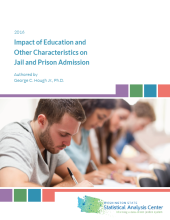This study examined a series of cohorts of ninth graders, beginning with new ninth graders in 2005-06 and ending with new ninth graders in 2010-2011. The experiences of these cohorts were looked at through 2015. By 2015, 10 percent of the 2006 cohort has been booked into jail or admitted into the Department of Corrections (DOC) at some point. The question of this report is, "How does education and other characteristics impact jail and prison admission?”
Males were over twice as likely as females to have been booked into jail and almost five time more likely to have been admitted to DOC. Six years after graduation, only 6 percent of females has been booked or admitted to corrections, whereas some 16 percent of males has had the same experience. In addition, 20 percent of the Native American and Black cohorts had contact with the justice system (jail or DOC); that is more than one-in-five and twice the total average.
In addition, students in the cohort who participated in free and reduced meal service (FRMS), which indicates lower economic status, had more contact with the Jail or DOC systems than those who did not. Students who graduated high school were much less likely to have contact with the justice system than those who dropped out of high school. For example, by 2015, 5.6 percent of the 2005-2006 ninth grade cohort who graduated from high school had been booked into jail at some point, compared with 24.9 percent of those in the same cohort who dropped out.


